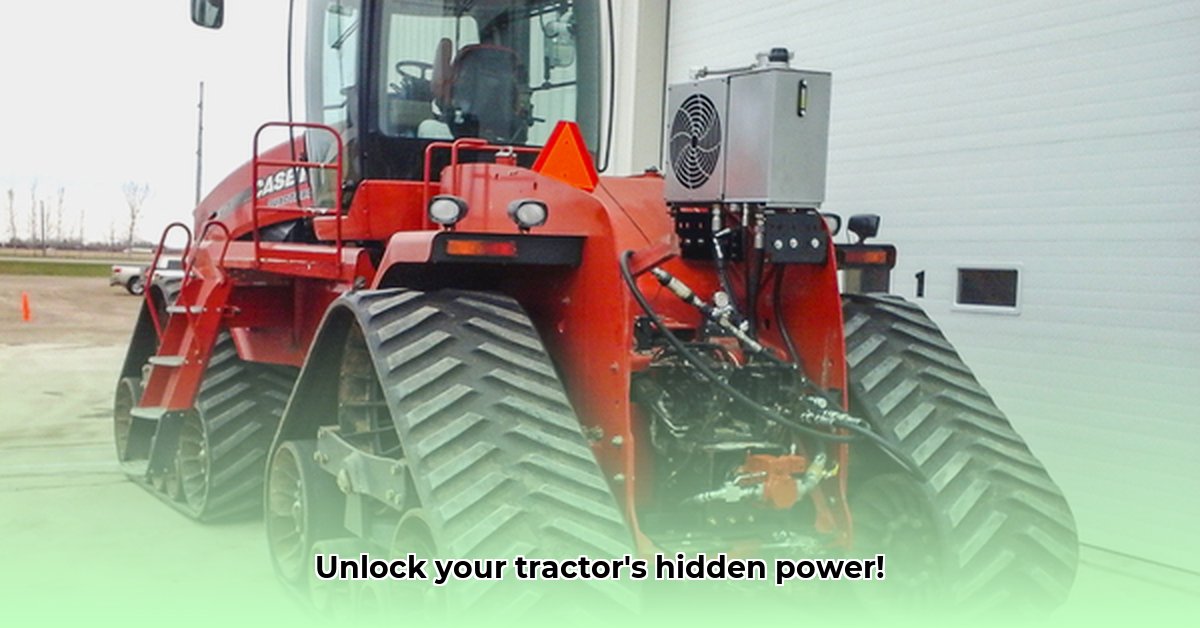
Understanding Your Hydraulic System: The Basics
Before tackling maintenance, understanding your tractor's hydraulic system is crucial. Think of it as a circulatory system for your tractor, powering everything from lifting implements to steering. This system uses hydraulic fluid—both the power source and lubricant. Keeping this fluid clean and at the correct level is vital for optimal performance. Tractors typically use either open-center or closed-center hydraulic systems. Open-center systems have oil constantly circulating, while closed-center systems only flow oil when needed. Knowing your system type guides your maintenance strategy. A leak in a closed-center system, for instance, is more critical than a similar leak in an open-center system. Did you know that a single small leak can lead to substantial fluid loss over time, impacting performance and potentially causing costly component damage?
Essential Maintenance Tasks: A Step-by-Step Guide
Regular maintenance is far cheaper than major repairs. This section provides a practical, step-by-step guide for preventing major problems.
Fluid Level Check: Check your hydraulic fluid level every 50 hours of operation. Low fluid levels can quickly lead to serious damage. Use the dipstick and ensure the level is within the manufacturer's recommended range (specified in your owner's manual). Ignoring this step can lead to catastrophic equipment failure. A simple check can avert disaster, a point often missed by many farmers.
Fluid Quality Check: Inspect the fluid's color. Cloudy, dark, or discolored fluid indicates contamination, requiring a fluid change to prevent damage. This prevents sludge buildup which reduces efficiency and can cause component failure.
Fluid Change: Change your hydraulic fluid according to the manufacturer's recommendations. This prevents sludge and gunk buildup for optimal performance. Always use the correct type of fluid specified in your owner's manual. Using the wrong fluid can irreparably damage system components.
Hose Inspection: Inspect all hydraulic hoses for cracks, bulges, or leaks. Damaged hoses are a safety hazard; high-pressure hydraulic lines are extremely dangerous if they fail. Immediately replace any questionable hoses. "Regular hose inspections are a simple yet crucial step," says Dr. Amelia Hernandez, Agricultural Engineering Professor at the University of California, Davis. "Ignoring them can lead to catastrophic failures."
Leak Detection: Regularly check for leaks. Even small leaks can cause significant fluid loss. Use soapy water to pinpoint the exact location of a leak for targeted repair.
Filter Maintenance: Change hydraulic filters according to the manufacturer's schedule. Clogged filters restrict fluid flow and strain the pump, potentially causing serious damage. This simple preventative measure can save thousands in repair costs.
Common Problems and Solutions
This section addresses common hydraulic problems and their solutions, empowering you to address issues quickly and efficiently.
Slow Response Time: Sluggish hydraulics often indicate low fluid levels or a clogged filter. Check fluid levels first; if levels are correct, replace the filter. Persistent problems may require professional attention for pump diagnostics.
Leaks: Leaks demand immediate attention. Pinpoint the leak’s source using soapy water, then repair or replace the faulty component and refill the system with the correct fluid. Small leaks, if ignored, can escalate rapidly into major problems.
Unusual Noises: Grinding, whining, or other unusual noises indicate potential wear and tear. These should be addressed promptly to prevent expensive breakdowns. A proactive approach is far more cost-effective compared to a reactive fix.
Reduced Pressure: This often signals pump or filter issues. Check the filter first; if the problem persists, the pump requires professional inspection and likely repair.
Safety Precautions: Protecting Yourself
Working with high-pressure hydraulic systems requires strict adherence to safety guidelines.
Eye and Hand Protection: Always wear safety glasses and gloves. Hydraulic fluid is harmful to skin and eyes.
Pressure Release: Before any maintenance, release pressure from the hydraulic system. Your owner's manual provides specific, safe pressure release instructions. Failure to do so can lead to serious injury.
Teamwork: Never work alone on the system. Have a trained helper nearby in case of emergencies.
Extending Hydraulic System Life: Best Practices
Beyond regular maintenance, these practices maximize your hydraulic system's lifespan:
Avoid Overloading: Never exceed your tractor's design limitations to prevent undue stress on the hydraulic system.
Proper Operation: Follow correct operating procedures. Avoid harsh maneuvers which can damage components.
Professional Service: Regular professional inspections help catch early issues, preventing them from developing into more serious and costly problems.
How to Prevent Costly Hydraulic System Failures in Farm Tractors
Regular maintenance is your first line of defense against costly hydraulic failures. Preventive maintenance on your tractor's hydraulic system translates to considerable cost savings and maximized operational efficiency. Are you maximizing your tractor's efficiency through regular maintenance?